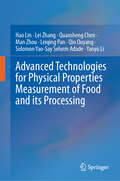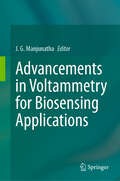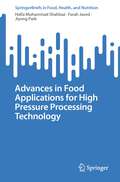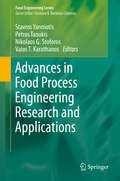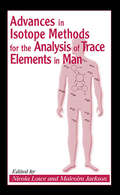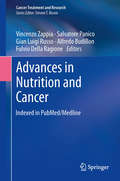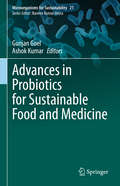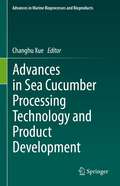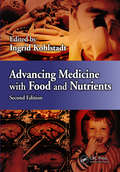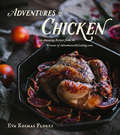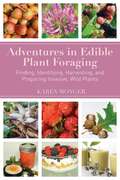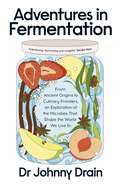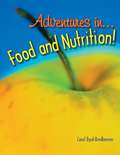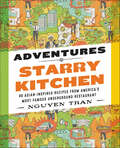- Table View
- List View
Advanced Techniques of Hypnosis: A Professional Hypnotist Reveals New Procedures for Inducing Both Deep and Self-Hypnosis
by Melvin PowersThere have been many books written on the therapeutic value of hypnosis. Numerous volumes have dealt with its history, and many more have been concerned with its various phenomena. There has, however, been comparatively little written about the actual technique of inducing the hypnotic state. Since this phase of hypnosis has been so woefully neglected, we have not had the rapid technical development our vital science so rightfully deserves. This volume is designed to remedy that lack.This book is dedicated to those who aspire to a fuller understanding of hypnotic procedures. It is my purpose to show you, the reader, how to develop any individual into a receptive, hypnotic subject, and to give you the necessary understanding and knowledge required to achieve this end. You will also be instructed in the use of my original techniques, which have proven to be so wonderfully effective in my long experience as a professional hypnotist. A careful reading of the book will not only be rewarding because of the wealth of information contained in it, but will also assure the reader maximum professional efficiency in the exciting, and fascinating practice of professional hypnosis.
Advanced Technologies for Physical Properties Measurement of Food and its Processing
by Lei Zhang Quansheng Chen Hao Lin Man Zhou Leiqing Pan Qin Ouyang Solomon Yao-Say Adade Yanyu LiThis book provides a comprehensive overview of the physical properties of foods and the cutting-edge technologies employed to measure them. Delving into key topics such as optical, thermal, acoustic, rheological, and textural properties, it provides a detailed examination of principles, measurement methods, and applications in food quality evaluation. While it discusses advanced technologies such as near-infrared spectroscopy, computer vision, spectral imaging, acoustic resonance analysis, electronic noses/tongues/eyes, and multi-sensor data fusion in detail, the book also introduces intelligent equipment design and real-time quality monitoring systems for the food industry, including emerging technologies like 4D printing and terahertz technology. The book also addresses critical questions about the application of these technologies in real-world scenarios, making it a must-read for those seeking to understand and apply the latest advancements in food science. This book is an invaluable resource for undergraduate and graduate students, researchers, and professionals in food science and engineering. It helps readers understand the principles of various non-destructive food quality measurement techniques and applies them to in-situ evaluation and in-field monitoring. It also serves as both a textbook and a reference guide, enabling readers to understand and apply advanced measurement and processing techniques for in-situ evaluation and in-field monitoring. By providing a thorough understanding of the principles and applications of food physical properties, this book ensures that its audience remains at the forefront of technological advancements in the field. The book contains several chapters originally written in the Chinese language. The translation was done with the help of artificial intelligence. A subsequent human revision was done primarily in terms of content.
Advanced Therapeutics in Pain Medicine
by Sahar Swidan and Matthew BennettChronic pain places a tremendous burden on both the patient and the healthcare system. The use of opioids to address pain has resulted in negative impacts. As practitioners work to undo the current opioid crisis, options to manage pain need a new approach. Advanced Therapeutics in Pain Medicine offers pioneering approaches to this intransigent problem providing a functional medicine approach toward treating pain. This book is dedicated to the advancement of non-opioid therapeutic options that offer real progress in reaching a future of better pain management. With an emphasis on pathophysiology, chapters review various types of pain and propose comprehensive treatment plans. These include manual therapies, novel pharmacologic and plant-based approaches, hormonal effects on pain pathways, as well as psychological and lifestyle interventions. Features · Written by a multi-discplinary team, the book provides clinicians with multiple non-opioid treatment considerations. · Enables practitioners to shift from a “one size fits all’ treatment approach toward individualized patient care. · Includes case studies to help educate the provider on how to implement treatment plans in practice. Written by a team of physicians, pharmacists, psychologists and researchers, this important book offers a much needed step forward in optimizing pain care and benefits practitioners who care for patients experiencing chronic pain.
Advancements in Voltammetry for Biosensing Applications
by J. G. ManjunathaThis book presents a detailed description of the recent advancements in voltammetry for biosensing applications. This book discusses the emerging research trends in the preparation of voltammetry-based electrochemical sensors for their applications in the analysis of medicinal, industrial, environmental, agricultural and food-related biological compounds. Living life is fundamentally influenced by the products utilized in day-to-day life, such as air, soil, water, food, environment, agriculture, and so on. The concentrations of the organic and inorganic biomolecules in these products may cause various problems to living beings which makes it necessary to analyze the biomolecules. The compactness of electrochemical approaches makes them well suited for on-site analysis. Voltammetric techniques like linear sweep voltammetry (LSV), cyclic voltammetry (CV), differential pulse voltammetry (DPV), square wave voltammetry (SWV), amperometry, and other methods give precise information about the analytes under study. Electrochemical approaches have several advantages in the investigation of significant organic and inorganic biomolecules because of their high sensitivity and selectivity, low detection limits, good adaptability, simplicity to use, and lower cost for instrumentations. Voltammetric methods lead to an in-depth understanding of the reaction kinetics and reaction mechanisms underlying the electrochemical reactions of the bioactive molecules, making them perfect tools for bio sensing applications. These features have resulted in the successful application of voltametric biosensing in the analysis of metal ions, hormones, vitamins, amino acids, agriculturally important and hazardous compounds, environmentally important and hazardous compounds, medicinal compounds, and so on. This book is targeted at scientific researchers in the field of electroanalytical chemistry and aims to inspire them to produce highly sensitive voltametric devices for biosensing applications. It also envisions to motivate researchers from other fields to carry out concurrent investigations in this newly emerging interdisciplinary research area i.e. voltammetric biosensing.
Advances in Agri-Food Biotechnology
by Rupesh Deshmukh Tilak Raj Sharma Humira SonahThis book presents biotechnological advances and approaches to improving the nutritional value of agri-foods. The respective chapters explore how biotechnology is being used to enhance food production, nutritional quality, food safety and food packaging, and to address postharvest issues. Written and prepared by eminent scientists working in the field of food biotechnology, the book offers authentic, reliable and detailed information on technological advances, fundamental principles, and the applications of recent innovations. Accordingly, it offers a valuable guide for researchers, as well as undergraduate and graduate students in the fields of biotechnology, agriculture and food technology.
Advances in Food Applications for High Pressure Processing Technology (SpringerBriefs in Food, Health, and Nutrition)
by Hafiz Muhammad Shahbaz Farah Javed Jiyong ParkThis Brief provides an overview of commercially successful current applications of high pressure processing (HPP) non-thermal technology. In recent years, HPP has gained acceptance in the industry for its use in the development of nutritious clean label food products which meet modern demands from health-conscious consumers. HPP products are now commercially available in many countries, and more than 400 HPP industrial equipment installations are currently in operation. Advances in Food Applications for High Pressure Processing Technology offers an in-depth discussion of recent applications of HPP for different food commodities, including fruit juices, vegetable and fruit products, meat products, ready-to-eat meals, avocado products, dairy products, dips and condiments, wet salads and sandwich fillings, fermented products and baby and infant foods.
Advances in Food Biochemistry
by Fatih YildizUnderstanding the biochemistry of food is basic to all other research and development in the fields of food science, technology, and nutrition, and the past decade has seen accelerated progress in these areas. Advances in Food Biochemistry provides a unified exploration of foods from a biochemical perspective. Featuring illustrations to elucidate m
Advances in Food Process Engineering Research and Applications (Food Engineering Series)
by Stavros Yanniotis Petros Taoukis Nikolaos G. Stoforos Vaios T. KarathanosThis is the second publication stemming from the International Congress on Engineering in Food, the first being Food Engineering Interfaces, based on the last ICEF10. The theme of ICEF 11, held in Athens, Greece in May 2011, is "Food Process Engineering in a Changing World. " The conference explored the ways food engineering contributes to the solutions of vital problems in a world of increasing population and complexity that is under the severe constraints of limited resources of raw materials, energy, and environment. The book, comprised of 32 chapters, features an interdisciplinary focus, including food materials science, engineering properties of foods, advances in food process technology, novel food processes, functional foods, food waste engineering, food process design and economics, modeling food safety and quality, and innovation management.
Advances in Isotope Methods for the Analysis of Trace Elements in Man (Modern Nutrition)
by Nicola Lowe Malcolm JacksonThere is increasing evidence that even minute amounts of trace elements can have profound effects on the human body. Advances in Isotope Methods for the Analysis of Trace Elements in Man describes new methods that are being developed to understand normal and abnormal trace element nutrition and metabolism. This book includes a wealth of pr
Advances in Nutrition and Cancer (Cancer Treatment and Research #159)
by Vincenzo Zappia Salvatore Panico Gian Luigi Russo Alfredo Budillon Fulvio Della RagioneThis book comprises proceedings from the Third International Conference on Advances in Nutrition and Cancer, held in Naples in May 2012. This highly multidisciplinary meeting analyzed "nutrition and cancer" from different perspectives and on the basis of distinct and up-to-date experimental approaches. Knowledge on the relation between lifestyle, diet, and cancer is explored in a number of contributions, and the role of dietary intervention in cancer patients is discussed. Issues of vital interest to the research community, such as epidemiological and experimental oncology (genetics, epigenetics, and the mechanisms of action of natural compounds in the diet), receive detailed consideration. A further key topic is the emerging molecular technologies (the "omics") that can cast light on the interplay between nutrition and human malignancies. Chapters take the form of reviews that include sections presenting expert opinions.
Advances in Plant Sprouts: Phytochemistry and Biofunctionalities
by Vikas Nanda Ishrat Majid Bababode Adesegun Kehinde Basharat DarThe demand for plant foods in all global markets has been increasing along with awareness of greenhouse gases generated from animal farming, expanded sentiments against animal slaughtering and common perception of the health benefits of plant food products. Accordingly, more attention has been placed on green processing of plant foods for the optimization of their nutritional and health benefits. Sprouted vegetable products have been studied and reported in many scientific investigations to qualitatively improve the phytochemistry, enhance the nutritional profile and improve the biological functionality potentials of such vegetables beyond their initial natural states. Vegetable sprouts have been reported to possess aspects that make them serviceable for the management of metabolic syndrome disorders such as diabetes, hypertension, cancer and other health issues related to cellular oxidation of body cells, and antimicrobial bioactive components have been isolated from vegetable sprouts. Advances in Plant Sprouts: Phytochemistry and Biofunctionalities provides a singular source on recent advances in studies about the dietetic and nutraceutical potencies of vegetable sprouts and increases awareness on the possibility of processing plant foods to make them more nutritionally beneficial. Green production is another important aspect of this text since plant foods processed by sprouting are free of agrochemicals, consume less energy and utilize less manpower, making them easy to produce and environmentally friendly as well. Consumption and production of sprouted vegetables has been increasing in recent years, and this text covers the production and nutritional aspects of all the major sprout groups.
Advances in Probiotics for Sustainable Food and Medicine (Microorganisms for Sustainability #21)
by Ashok Kumar Gunjan GoelThis book focuses on probiotics as sustainable foods and medicines, discussing issues such as screening and identification of probiotics, health claims, and advances in processing technologies, as well as food safety. Based on sound scientific research, the book is a unique reference resource for food scientists interested in development of probiotic based functional foods and their marketing. It will also appeal to those working in the area of regulations regarding the use of and health claims for fermented foods, both locally and globally.
Advances in Sea Cucumber Processing Technology and Product Development (Advances in Marine Bioprocesses and Bioproducts)
by Changhu XueSea cucumbers belong to the Phylum Echinodermata. There are more than 900 recorded species of sea cucumber of which more than 40 are edible. As a food source, sea cucumbers are rich in protein, low in fat, rich in collagen, sulfated polysaccharides, phospholipids, glycolipids, saponins and other functional components. Therefore, sea cucumbers have important nutritional and medicinal value. Growing awareness of these health benefits has promoted growth in marine aquaculture and processing technologies for the development of sea cucumber products for many applications.Novel perspectives of nutritional functions and processing technologies of sea cucumbers are defined in this book. The chemical structure and nutritional function of sea cucumbers are systematically reviewed. These include the functional/nutritional components, the endogenous enzymatic properties related to processing efficiency and product quality, and the efficient preparation technology of functional components. The traditional processing technology is presented as the background context to highlight the advances in new processing technologies including low-temperature cooking technology based on controllable negative pressure system, heat pump-hot-blast air combined drying technology, microwave sterilization of instant sea cucumber, collagen stabilization technology. The book finishes with the authentication of sea cucumber types and origin, quality standards, product quality control systems and food safety requirements.
Advances in the Assessment of Dietary Intake.
by Dale A. Schoeller M. WesterterpDiet is a major factor in health and disease. Controlled, long-term studies in humans are impractical, and investigators have utilized long-term epidemiological investigations to study the contributions of diet to the human condition. Such studies, while valuable, have often been limited by contradictory findings; a limitation secondary to systematic errors in traditional self-reported dietary assessment tools that limit the percentage of variances in diseases explained by diet. New approaches are available to help overcome these limitations, and Advances in the Assessment of Dietary Intake is focused on these advances in an effort to provide more accurate dietary data to understand human health. Chapters cover the benefits and limitations of traditional self-report tools; strategies for improving the validity of dietary recall and food recording methods; objective methods to assess food and nutrient intake; assessment of timing and meal patterns using glucose sensors; and physical activity patterns using validated accelerometers. Advances in the Assessment of Dietary Intake describes new avenues to investigate the role of diet in human health and serves as the most up-to-date reference and teaching tool for these methods that will improve the accuracy of dietary assessment and lay the ground work for future studies.
Advancing Medicine with Food and Nutrients
by Ingrid KohlstadtFood and nutrients are the original medicine and the shoulders on which modern medicine stands. But in recent decades, food and medicine have taken divergent paths and the natural healing properties of food have been diminished in the wake of modern technical progress. With contributions from highly regarded experts who work on the frontlines of disease management, the bestselling first edition of Advancing Medicine with Food and Nutrients, Food and Nutrients in Disease Management effectively brought food back into the clinical arena, helping physicians put food and nutrients back on the prescription pad.Board-certified in General Preventive Medicine, Ingrid Kohlstadt, MD, MPH has been elected a Fellow of the American College of Nutrition and a Fellow of the American College of Preventive Medicine. Guided by Dr. Kohlstadt, this authoritative reference equips clinicians with the information they need to fully utilize nutritional medicine in their practice. New in the Second Edition Toxic exposures such as molds, microbial infections, xenoestrogens, heavy metals, and inert nanoparticles Food safety issues: precautions for patients with preexisting medical conditions, adequate labeling of food allergens such as gluten, potential adverse effects of artificial sweeteners, consequences of applying ionizing radiation to food, food-borne mycotoxins, critical food restrictions following bariatric surgery, precautions for preparing food in the home Consumer advocacy issues on navigating claims of medical foods and dietary supplements Physical forces on nutritional needs, such as ultraviolet light initiating vitamin D synthesis, non-ionizing radiation’s effects on brain glucose metabolism and excess body fat’s effects on inflammation and hydration Preventive medicine and how to preserve resiliency at the individual and public health levels Written by doctors for doctors, Advancing Medicine with Food and Nutrients, Second Edition reunites food and medicine. Buttressed with new evidence, leading physicians on the frontlines of disease management apply the latest scientific advances to the clinical practice of medicine. Each chapter offers adjuncts to standard care, fewer side effects, improved risk reduction, or added quality of life.An article by Ingrid Kohlstadt on education and nutrition appeared in TIME Magazine online on November 12, 2014.
Advent: Festive German Bakes to Celebrate the Coming of Christmas
by Anja DunkSelected for Jamie Oliver's Cookbook Club‘I love it. As soon as I opened this, I felt it was Christmas.’ – Diana HenryAdvent celebrates the magical run-up to Christmas with over 100 classic German baking recipes.The Advent season is one of the most special times of the year, when candles twinkle, the Christmas tree is decorated, and the smells of cinnamon, nutmeg and clove fill the kitchen.In the modern classic Advent, Anja Dunk shares her recipes for the very best of traditional German festive bakes. From lightly spiced Lebkuchen, frosted cinnamon stars, jam-filled ginger hearts, snow-capped coconut macaroons, to marzipan-filled Stollen, edible tree decorations, lucky meringue mushrooms and a gingerbread house dripping with candies and sugar icicles, you will find delectable spiced treats to fill your Bunter Teller and share with friends and family.Featuring Anja’s own linocut illustrations and evocative photography, this stunning, burgundy-coloured clothbound edition will be a family favourite for many years to come. The weeks of Advent hold all the sweet, almost unbearable anticipation of Christmas for days on end and this gorgeous book embraces that fairy-tale feeling within its pages.
Adventures in Chicken: 150 Amazing Recipes from the Creator of AdventuresInCooking.com
by Eva Kosmas FloresThe popular food blogger covers everything from essential skills to innovative recipes that “will satisfy the cravings of chicken lovers” (Library Journal).Chicken is the most popular meat in the world and can be easily adapted to almost any cuisine, from rustic Italian dishes to Asian-inspired curries. Still, it can be challenging to think of new ways to cook the same old wings or chicken thighs. Enter Eva Kosmas Flores, creator of the acclaimed blog Adventures in Cooking, with 150 recipes that transform chicken into something bold, new and delectable.This is a book for avid home cooks who want to push their cooking to the next level with the best versions of classics like Chicken Marsala with Balsamic Caramelized Onions and Pork Belly or innovative temptations such as Korean Barbecue Drumsticks with Ginger-Pear Sauce. There are sections on chicken cooking techniques, how to make perfect stock, and more, making this an indispensable guide for poultry lovers everywhere.
Adventures in Edible Plant Foraging: Finding, Identifying, Harvesting, and Preparing Native and Invasive Wild Plants
by Karen MongerPurchasing vegetables and leafy greens can become rather pricy. Moreover store-bought greens often contain unhealthy pesticides and chemicals that can be harmful to your health. Foraging for wild plants is a cost effective and healthy alternative. Harvested wild plants are cheaper, and much healthier with a significantly higher nutritional value than what you typically purchase in grocery stores contain. On top of that, harvesting your own plants will force you to get out, exercise, and explore the great outdoors, which is an excellent way to stay fit and spend time with your family. Written with novice foragers in mind, Adventures in Edible Plant Foraging, serves as a simplified guide to edible plants that can be found throughout North America, and includes a glossary of botanical terms. This all encompassing guide will teach you how to prepare for your first foray into foraging--what to bring and what to watch out for--and show you how to identify various edible wild plants native to your own backyard, the forest, fields and the sandy shores along lakes and beaches. With over 90 full color photographs and 20 recipes for soups, salads, muffins, desserts, and more, this book is a must have for anyone looking to save money and begin their first expedition into foraging.
Adventures in Fermentation: From Ancient Origins to Culinary Frontiers, an Exploration of the Microbes That Shape the World We Live In
by Dr Johnny Drain'Entertaining, illuminating and insightful' Sandor Katz'A gripping story full of glorious gems' Fergus Henderson'Wild, funny, well researched, and full of flavour' René Redzepi, founder of Noma 'Clever, clear and insightful, this book is an indispensable guide to the new scientific and gastronomic frontier of fermentation' Heston Blumenthal***Embark on a tantalising journey into the weird and wonderful world of fermentation.Dr Johnny Drain has spent his career exploring how fermentation has shaped the bodies we inhabit, the foods we eat and the world we live in. From making live yoghurt in his grandma’s kitchen, to fermenting butter at the world’s best restaurant, Noma, Dr Drain’s fascination with the magic of fermentation has led him around the globe. Adventures in Fermentation charts his culinary escapades and his scientific discoveries to create an unprecedented depiction of the power of the microbial world.With irresistible wit and verve, chef and scientist Dr Drain illuminates the vast and unsung possibilities that fermentation brings to the table – from sweet enzyme syrups made from red mangos in Brazil to perfecting the fine art of fuzzy koji and umami-rich miso in Japan – and shares recipes for his culinary delights along the way.Whether you are an aspiring fermenter, interested in how fermented food can improve your gut health, or simply curious about the wonders of microbial life, this book will transform the way you see – and taste – the world.
Adventures in Food and Nutrition!
by Carol Byrd-BredbennerAdventures in Food and Nutrition! is designed to help you explore the exciting world of food and nutrition. You will explore beyond familiar foods and preparation methods. A multicultural, multiethnic emphasis will encourage you to try new foods.
Adventures in Food and Nutrition!
by Carol Byrd-BredbennerIntroduce your students to food and nutrition with Adventures in Food and Nutrition! Packed with student appeal, this full-color text generates student interest with action photos, interesting activities, and real-world experiments. The text encourages students to develop scientific and inquiry skills as they learn about nutrition, food management, and preparation. The text is written at a lower level for younger students or beginning level classes. -- Multicultural focus, reflecting foods from a cross section of diverse backgrounds. -- Math and science applications and activities are provided throughout the text and in special-interest features. -- Involves students in the science and creativity of preparing meals and snacks. -- Chapters include Objectives, New Terms, Review Questions, Application Questions, Activities, and a Summary.
Adventures in Food and Nutrition! (Fifth Edition)
by Carol Byrd-BredbennerAdventures in Food and Nutrition! is a great resource for helping your students begin an exciting study of nutrition, food management, and preparation. The appealing, youthful writing style and colorful photographs draw students' attention, and the lower reading level makes this text anexcellent choice for younger students and introductory classes. Interesting features appear throughout the text to encourage students to use math and science concepts as they consider the link between nutrition and health. These features also introduce students to food technology innovations,increase their appreciation of diverse cultures, and motivate them to explore careers. In addition, problem-solving scenarios empower students to develop critical-thinking skills as they apply learning.
Adventures in Good Cooking
by Duncan HinesAn all-American classic: &“For the first time in decades, we can revisit the best recipes from some of the best restaurants of the &’40s and &’50s.&” —St. Louis Post-Dispatch Adventures in Good Cooking was a culinary landmark. Duncan Hines had left his native Kentucky and crisscrossed the country as a traveling salesman, becoming a national tastemaker in the process by reporting on the many restaurants he visited. Eventually, his recommendations became so popular that he published his first cookbook at age fifty-nine. This bestselling collection featured recipes contributed by select restaurants from coast to coast as well as crowd-pleasing family favorites, and it helped to raise the standard for home cooking in America. Filled with succulent treats, from the Waldorf-Astoria&’s Chicken Fricassee to the Oeufs a la Russe served at Antoine&’s Restaurant in New Orleans to Mrs. Hines&’s own Christmas Nut Cake, this book includes classic recipes from top chefs and home cooks alike. Includes a new introduction by Hines biographer Louis Hatchett and a valuable guide to the art of carving
Adventures in Slow Cooking: 120 Slow Cooker Recipes for People Who Love Food
by Sarah DiGregorio“An exciting and refreshingly unbiased guide to slow cooking . . . even die-hard fans of these appliances will learn something new.” —Library Journal, starred reviewSarah DiGregorio, a James Beard nominated food writer, has reinvented slow cooking for a generation that cooks for fun and flavor, taking a fresh approach to reclaim this versatile tool without sacrificing quality or taste.Showcasing a beautiful, engaging design, inviting color photographs, and 105 original, innovative recipes thoroughly tested in a variety of brands of slow cookers, Adventures in Slow Cooking provides a repertoire of delicious food. Inside you’ll find ideas for flavorful sweet and savory slow cooker dishes, including:Whipped Feta, Red Pepper and Olive DipGranola with Pistachios, Coconut and CardamomSavory Overnight Oatmeal with Bacon, Scallions and CheddarTurkey-Spinach Meatballs Stuffed with MozzarellaSpicy Kimchi and Pork RamenOrange, Olive and Fennel Chicken TagineDaal with Mango and Mustard SeedsFarro Bowl with Smoked Salmon, Yogurt, and Everything-Bagel SpiceOxtail and Short Rib PhoCorn, Mushroom and Zucchini TamalesProper Red Sauce Eggplant ParmPeach-Orange Blossom JamMatcha-White Chocolate Pots de CrèmeCardamom-Molasses Apple Upside-Down CakeStar Anise-Black Pepper Hot ToddySarah also provides tips and tricks that will help cooks get the most out of today’s slow cookers. With a foreword by Grant Achatz, modernist chef and advocate of the slow cooker, Adventures in Slow Cooking makes this convenient appliance an indispensable tool for the modern kitchen.“DiGregorio has made the slow cooking downright sophisticated.” —Epicurious “Fun and useful. . . . DiGregorio uses a multistep approach to help build flavor in the slow cooker . . . a must-have for slow-cooker fans.” —Publishers Weekly
Adventures in Starry Kitchen: 88 Asian-Inspired Recipes from America's Most Famous Underground Restaurant
by Nguyen TranThe behind-the-scenes story of America’s most famous underground restaurant, featuring more than eighty-eight deceptively simple and unbelievably delicious pan-Asian recipes and dozens of luscious full color photos.In 2008, as the American economy cratered, newly unemployed Nguyen Tran and his newly unemployed wife-to-be, Thi, opened an off-the-grid eatery in their small Los Angeles studio apartment. Word of their fabulous food quickly spread, turning their culinary "speakeasy," Starry Kitchen, into an underground sensation—and the #1 Asian fusion restaurant in L.A. on Yelp. Threatened by the city’s health inspector, Nguyen and Thi transformed Starry Kitchen into an acclaimed and wildly popular pop-up restaurant in a downtown sushi joint. But their success was only beginning. As their clientele exploded, thanks to raves in the Los Angeles Times, Nguyen and Thi moved to a bigger space of their own in Chinatown, where they helped make the neighborhood the epicenter of L.A.’s burgeoning food scene. Adventures in Starry Kitchen chronicles Starry Kitchen’s DIY evolution—"this beautiful accident gone right"—the mayhem, mishaps, misdemeanors, milestones, and amazing meals that have contributed to (and nearly derailed) its success. As they tell their story, the Trans share more than eighty-eight easy-to-follow pan-Asian recipes—mouthwatering and flavorful comfort cuisine, including Claypot Striped Bass, Buttermilk Beer Beignets, Singaporean Chili Crab, Double-Fried Chicken Wings and, of course, Starry Kitchen's trademark Crispy Tofu Balls. Whether you’re cooking for two, four, or sixty, Adventures in Starry Kitchen demonstrates you don’t have to be a desperately hip (or even trained) chef to master sensational modern food that will amaze and delight.

